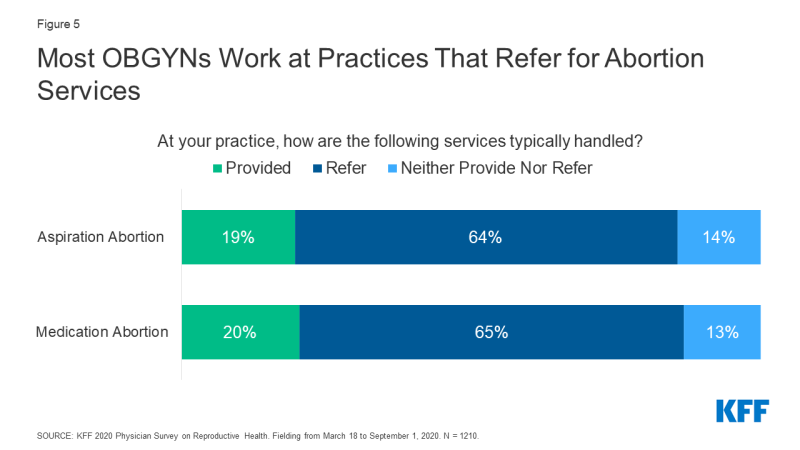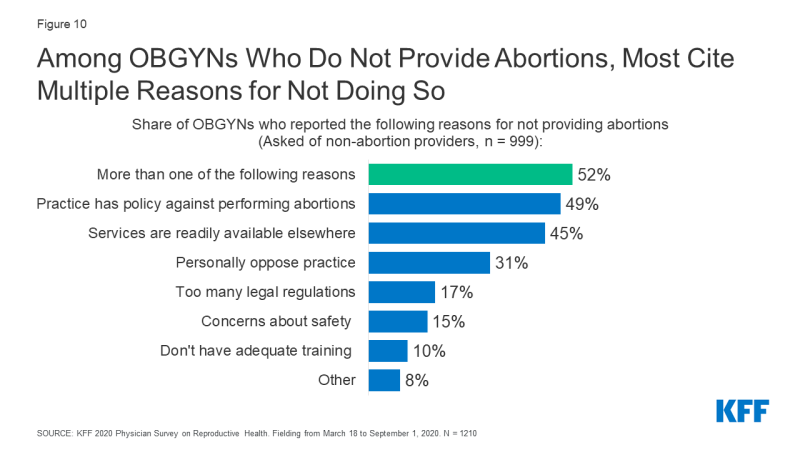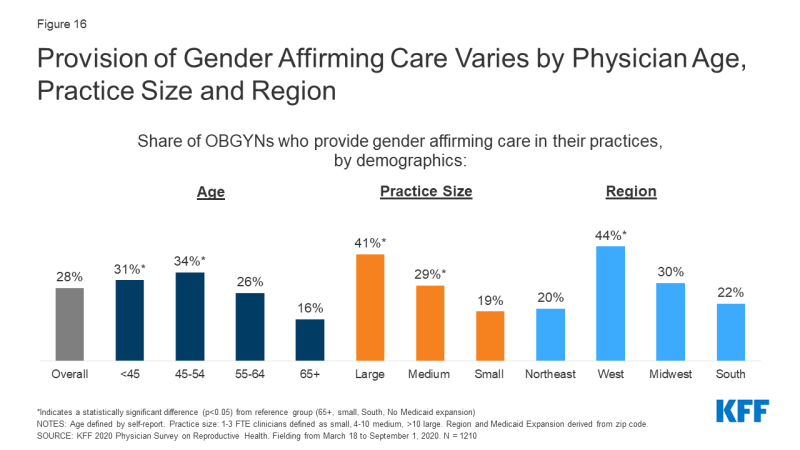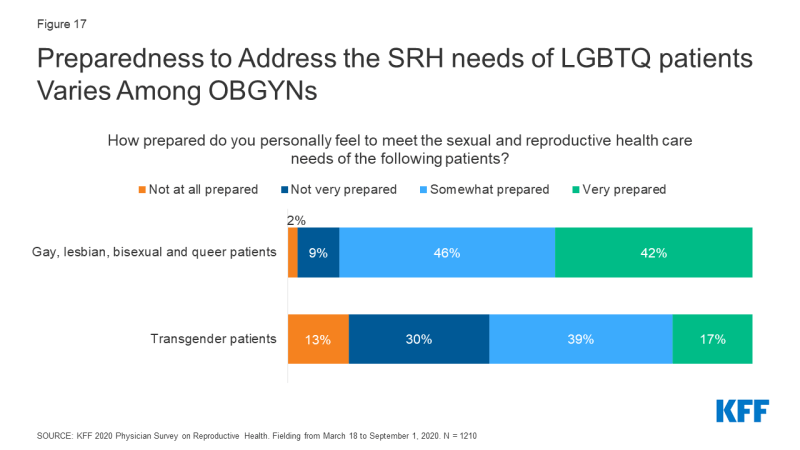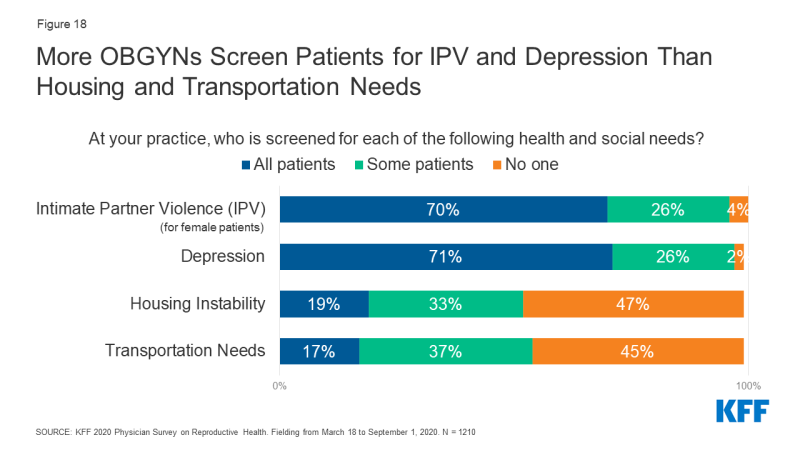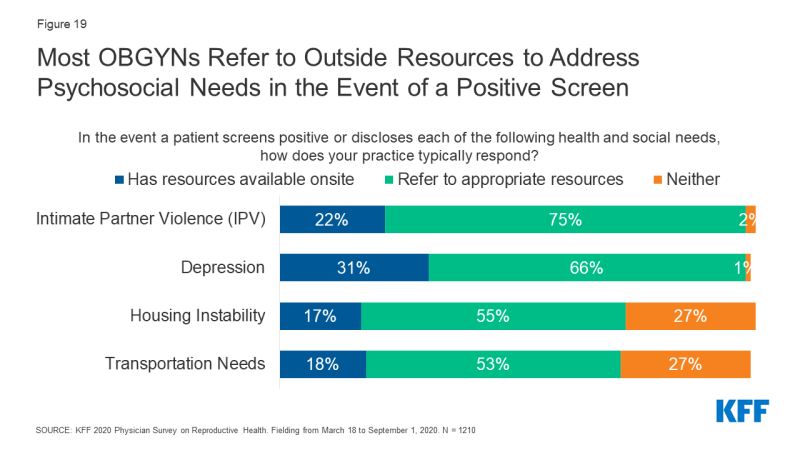OBGYNs and the Provision of Sexual and Reproductive Health Care: Key Findings from a National Survey
Clinical Care
An updated version of this report was released on June 21, 2023 and can be found here.
Contraception
Provision of Contraception
The vast majority of OBGYNs prescribe/provide oral contraceptive pills (OCPs) (98%), intrauterine devices (IUDs) (96%), vaginal rings (96%), contraceptive injections (Depo-provera) (95%), and the patch (91%). Slightly fewer provide contraceptive implants (Nexplanon) (84%); of note, providers must complete a 2-hour live training from the manufacturer in order to provide Nexplanon, which may serve as a hurdle to some in delivering this method of contraception. Notably fewer OBGYNs provide diaphragms or cervical caps (65%) than other methods of non-emergency contraceptives (Figure 1).
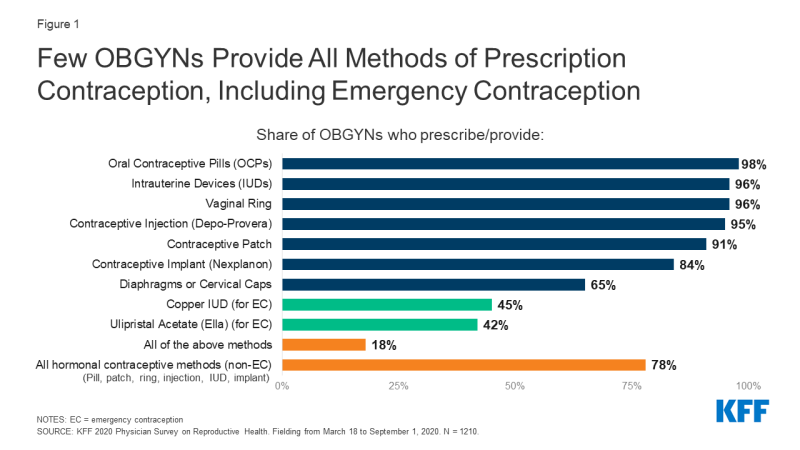
Figure 1: Few OBGYNs Provide All Methods of Prescription Contraception, Including Emergency Contraception
The majority of OBGYNs (78%) provided all hormonal methods of contraception, including the contraceptive pill, patch, ring, injection, IUD and implant (Figure 1). Fewer (54%) provided all hormonal methods, plus diaphragms or cervical caps as a barrier method. About half (51%) provided all hormonal methods, plus at least one form of prescription emergency contraception, either the copper IUD or ulipristal acetate/Ella. Just 18% of OBGYNs reported prescribing all nine of the contraceptive methods asked about, including all hormonal methods (pill, patch, ring, injection, IUD and implant), a barrier method (diaphragm or cervical cap) and both methods of prescription emergency contraception (copper IUD and ulipristal acetate/Ella).
A higher share of OBGYNs who are female compared to male, younger compared to older, and work in large practices compared to small reported providing all methods of contraception (Table 2).
| Table 2: Characteristics of OBGYNs who Provide All Methods of Contraception | ||
| Characteristic | Share of OBGYNs who Provide all Methods of Contraception | |
| Overall | 18% | |
| Gender | Female | 21* |
| Male | 12 | |
| Age | <45 | 28* |
| 45-54 | 19* | |
| 55-64 | 13* | |
| 65+ | 5 | |
| Practice Size | Large | 24* |
| Medium | 19 | |
| Small | 13 | |
| *Indicates a statistically significant difference (p<0.05) from reference group in bold NOTES: “All methods contraception” defined as providing/prescribing hormonal contraceptive pills, patch, ring, diaphragm or cervical caps, IUDs, implants, injectables and emergency contraception (Copper IUD and Ulipristal Acetate/Ella). Gender and age defined by physician self-report. Practice size defined by number of full-time equivalent physicians and advance practice clinicians (small ≤3 FTE, medium 4-10, large >10). SOURCE: KFF 2020 Physician Survey on Reproductive Health. Fielding from March 18 to September 1, 2020. N = 1210 |
||
Provision of other SRH services seemed to cluster among OBGYNs who provided all contraceptive methods. For example, OBGYNs who provided all methods of contraception were more likely to provide abortions, gender affirming care, pre-exposure prophylaxis (PrEP) for HIV and expedited partner therapy (EPT) for gonorrhea and chlamydia compared to OBGYNs who do not provide all methods of contraception (Figure 2).
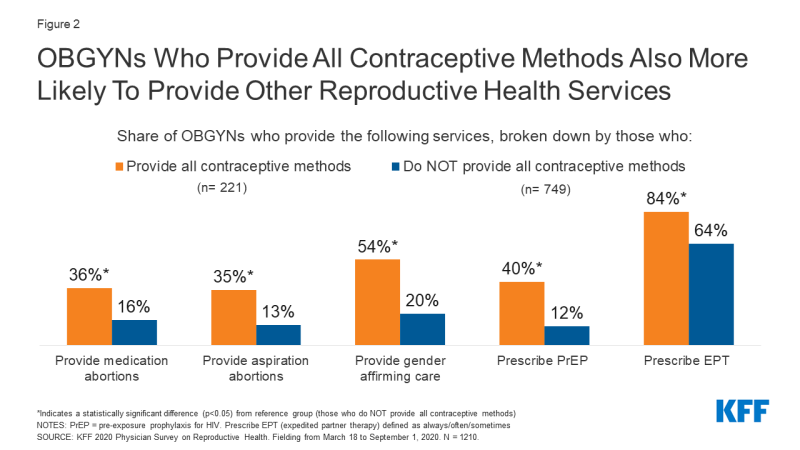
Figure 2: OBGYNs Who Provide All Contraceptive Methods Also More Likely To Provide Other Reproductive Health Services
Provision of Emergency Contraception
Among the three commonly used methods of emergency contraception (EC), the copper IUD and ulipristal acetate (Ella) must be prescribed, and levonorgestrel (Plan B) can be purchased over the counter. For the two methods that must be prescribed/provided by a clinician, fewer than half of OBGYNs provided copper IUDs (45%) and Ella (42%) as forms of emergency contraception (Figure 1); 38% provided neither, 26% provided both methods, 17% provided the copper IUD only and 15% provided Ella only (Figure 3).
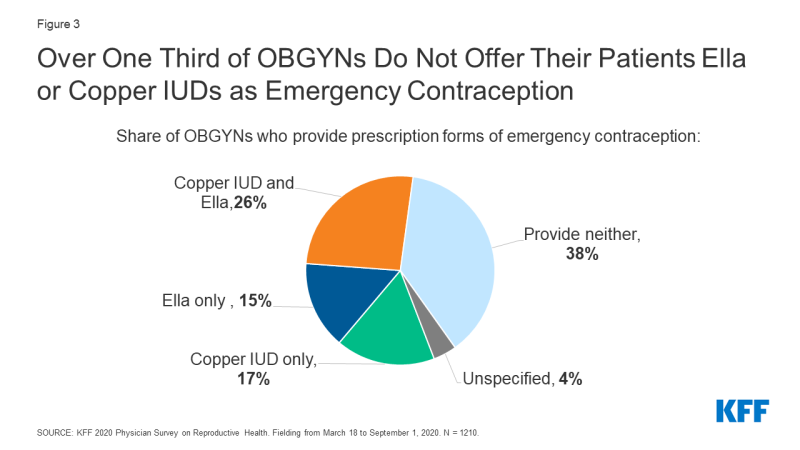
Figure 3: Over One Third of OBGYNs Do Not Offer Their Patients Ella or Copper IUDs as Emergency Contraception
A higher share of female OBGYNs provided copper IUDs and Ella compared to male OBGYNs, as did younger OBGYNs (age <55) compared to older OBGYNs (age 65+). Geographically, a higher percentage of OBGYNS in the Northeast and West offered copper IUDs and Ella for emergency contraception compared to the South, as did OBGYNs in states that have expanded Medicaid compared to those that have not. A larger share of abortion providers offered the copper IUD as EC and Ella compared to non-abortion providers (Table 3).
| Table 3: Emergency Contraception (EC) Provision | |||
| Characteristic | Provides following forms of EC: | ||
| Copper IUD | Ulipristal Acetate (Ella) | ||
| Overall | 45% | 42% | |
| Gender | Female | 51* | 46* |
| Male | 33 | 36 | |
| Age | <45 | 65* | 51* |
| 45-54 | 45* | 43* | |
| 55-64 | 29 | 37 | |
| 65+ | 22 | 30 | |
| Region | Northeast | 47* | 47* |
| West | 58* | 55* | |
| Midwest | 47* | 40 | |
| South | 34 | 32 | |
| Practice in Medicaid Expansion State | Yes | 52* | 47* |
| No | 30 | 32 | |
| Provide Abortions | Yes | 59* | 61* |
| No | 42 | 37 | |
| *Indicates statistically significant difference (p<0.05) from reference group in bold NOTES: Gender, age and provides abortions defined by self-report. Region and Medicaid Expansion derived from zip code. SOURCE: KFF 2020 Physician Survey on Reproductive Health. Fielding from March 18 to September 1, 2020. N = 1210 |
|||
Considerations for LARCs and injectables
The majority of OBGYNs (84%) reported they provide both types of LARCs (IUDs and implants) and 11% provided just one type. However, among those who provide IUDs and implants respectively, only about two in five provided same-day placement for IUDs (40%) and implants (39%). This means that at the majority of OBGYN practices, patients must make more than one trip to the clinic to obtain a LARC.
Provision of same-day LARCs was more common among OBGYNs who are younger, work in health centers/clinics, in large practices, and outside the South (Table 4). Additionally, a larger share of OBGYNs who provided all methods of contraception offered same-day IUD (64% vs. 33%) and implant (62% vs. 32%) insertions compared to those who did not offer all contraceptive methods. A higher percentage of abortion providers provided same-day IUD (56% vs. 36%) and implant (54% vs. 35%) insertions compared to non-abortion providers, which may be important for some patients as part of post-abortion care.
| Table 4: Provision of same-day LARCs, by demographics | |||
| Characteristic | Provides same-day placement of: | ||
| IUDs | Implants | ||
| Overall | 40% | 39% | |
| Age | <45 | 44* | 45* |
| 45-54 | 46* | 41 | |
| 55-64 | 36 | 35 | |
| 65+ | 27 | 28 | |
| Practice type | Health center/clinic | 62* | 61* |
| Private office-based | 37 | 36 | |
| Practice size | Large | 61* | 60* |
| Medium | 39* | 36 | |
| Small | 28 | 29 | |
| Region | Northeast | 43* | 41 |
| West | 49* | 49* | |
| Midwest | 43* | 45* | |
| South | 30 | 29 | |
| *Indicates statistically significant difference (p<0.05) from reference group in bold NOTES: Age defined by self-report. Private office-based = private practice or HMO, Health center/clinic = community health center/reproductive health care clinic/government operated clinic. Practice size: 1-3 FTE clinicians small, 4-10 medium, >10 large. Region derived from zip code. SOURCE: KFF 2020 Physician Survey on Reproductive Health. Fielding from March 18 to September 1, 2020. N = 1210 |
|||
Insurance restrictions and requirements around prior authorization for contraception likely play a role in whether or not providers offer same-day LARCs. We asked OBGYNs whether the Medicaid plan they bill most often required them to obtain prior authorization for specific contraceptives; a higher share of those who had not been required to obtain prior authorization for contraceptives provided same day placement of IUDs (52% vs. 31%) and implants (52% vs. 32%) compared to OBGYNs that reported prior authorization had been required.
Beyond insurance hurdles, practices may not offer same-day LARC insertion if they do not have the contraceptive methods stocked onsite. Among those that provide IUDs, four in five (79%) stock IUDs onsite; nearly three in four implant providers (73%) stock implants onsite; and about half (51%) of OBGYNs who provide injectables stock them on site. Stocking these contraceptive methods onsite was more common among OBGYNs in health centers/clinics than private office-based practices, in large and medium size practices rather than small, and among OBGYNs who provide all methods of contraception compared to those who do not (Table 5).
Additionally, a larger share of OBGYNs who reported prior authorization was not required for specific contraceptives stocked IUDs (90% vs. 75%) and implants (87% vs. 65%) compared to OBGYNs who reported prior authorization was required for specific contraceptives. This suggests that requirements around prior authorization could play a role limiting the availability of same-day LARC insertion.
| Table 5: Stocking Contraceptive Methods Onsite Varies by Practice Characteristics | ||||
| Characteristic | Among OBGYNs who provide these methods of contraception, share who stock: | |||
| IUDs | Implants | Injectables | ||
| Overall | 79% | 73% | 51% | |
| Practice type | Health center/clinic | 92* | 93* | 84* |
| Private office-based | 77 | 69 | 46 | |
| Practice size | Large | 94* | 89* | 72* |
| Medium | 83* | 73* | 50* | |
| Small | 62 | 58 | 38 | |
| Provides All Methods of Contraception | Yes | 94* | 91* | 74* |
| No | 74 | 67 | 45 | |
| *Statistically significant difference from reference group in bold NOTES: Practice type: Private office-based = private practice or HMO, Health center/clinic = community health center/reproductive health care clinic/government operated clinic. Practice size: 1-3 FTE clinicians small, 4-10 medium, >10 large. Medicaid Expansion derived from zip code. All contraception = pill, patch, ring, IUD, implant, injection, diaphragm, Copper IUD and Ella for EC SOURCE: KFF 2020 Physician Survey on Reproductive Health. Fielding from March 18 to September 1, 2020. N = 1210. |
||||
Fertility Awareness-Based Methods
Under the Trump Administration, there was increased federal support for and attention to fertility awareness-based methods (FABM) of contraception – that is tracking ovulation. This includes instruction on monitoring basal body temperature, cervical mucus, hormone production, cervical position, and calendar tracking. For patients seeking contraceptive services, most OBGYNs reported that a minority of patients request information on FABM. More than three fourths (78%) of OBGYNs said less than a quarter of patients requested this information (Figure 4).
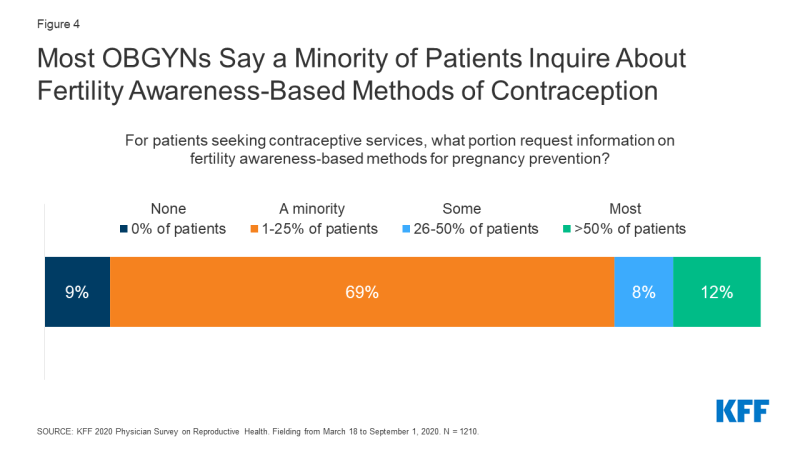
Figure 4: Most OBGYNs Say a Minority of Patients Inquire About Fertility Awareness-Based Methods of Contraception
Abortion
Abortion provision by U.S. OBGYNs
One in five OBGYNs said their practice provides medication abortions (20%) and aspiration abortions (19%), but the majority of OBGYNs did not provide abortions for pregnancy termination in their practices. Nearly two-thirds referred patients to outside providers for these services, and a minority neither provided nor referred for these services (Figure 5). These data are fairly consistent with prior estimates of abortion provision in the U.S. (Stulberg et al. 2012, Grossman et al. 2019).
While 75% of OBGYNs surveyed did not provide abortions within their practices, 23% provided at least one type of abortion; 16% offered both medication and aspiration abortions in their practices, 4% provided medication abortions only and 3% provided aspiration abortions only (Figure 6). Among abortion providers, seven in ten (71%) provided both medication and aspiration abortions, suggesting that most OBGYNs who choose to provide abortions offer more than one method of pregnancy termination. Having this option is important to many people seeking abortion care, who may prefer one method over another.
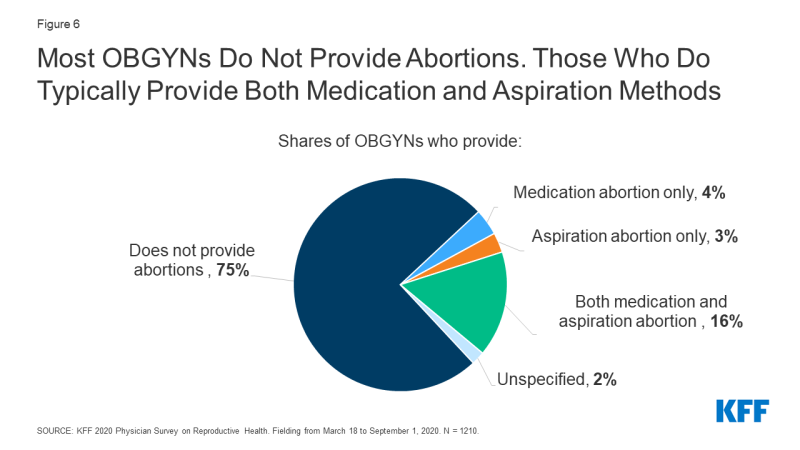
Figure 6: Most OBGYNs Do Not Provide Abortions. Those Who Do Typically Provide Both Medication and Aspiration Methods
Characteristics of OBGYNs who provide abortions
The provision of abortion services varied by region and urbanicity. A larger percentage of OBGYNs in urban and suburban locations than those in rural locations provided medication and aspiration abortions, while a larger share of OBGYNs in the Northeast and West reported providing both types of abortions compared to OBGYNs in the Midwest and South (Figure 7). Similar trends by urbanicity and region were found by Stulberg et al. in their 2008 survey of U.S. OBGYNs.
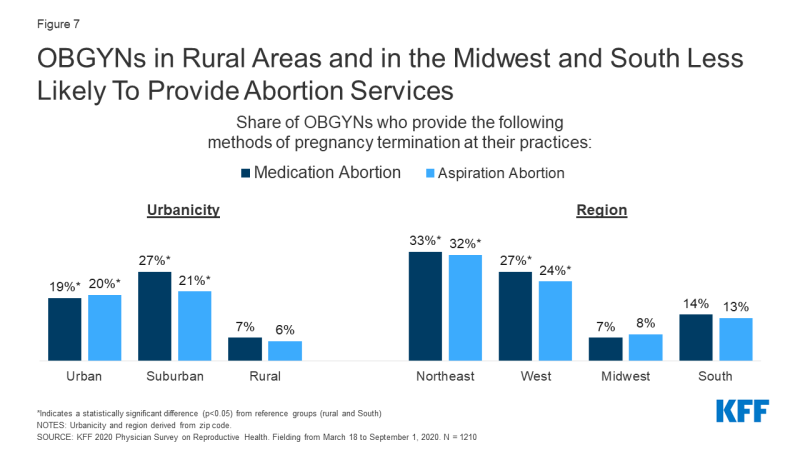
Figure 7: OBGYNs in Rural Areas and in the Midwest and South Less Likely to Provide Abortion Services
Additionally, a higher share of the youngest group of OBGYNs, age <45, provided medication abortions within their practices compared to older physicians, age 65+. More OBGYNs at large practices offered aspiration abortions than those at medium and small practices. No differences were seen by practice size for medication abortions (Table 6).
| Table 6: Abortion Provision Varies by Physician and Practice Characteristics | |||
| Share of OBGYNs who provide: | |||
| Medication abortions | Aspiration abortions | ||
| Overall | 20% | 19% | |
| Age | <45 | 25* | 22 |
| 45-54 | 22 | 20 | |
| 55-64 | 14 | 15 | |
| 65+ | 13 | 14 | |
| Practice type | Health Centers/Clinics | 23 | 22 |
| Private Office-Based | 19 | 18 | |
| Practice Size | Large | 23 | 27* |
| Medium | 21 | 18 | |
| Small | 15 | 15 | |
| Urbanicity | Urban | 19* | 20* |
| Suburban | 27* | 21* | |
| Rural | 7 | 6 | |
| Region | Northeast | 33* | 32* |
| West | 27* | 24* | |
| Midwest | 7 | 8 | |
| South | 14 | 13 | |
| *Statistically significant difference (p<0.05) from reference group in bold NOTES: Age defined by self-report. Practice type: private = private practice/HMO, public = community health center/reproductive health care clinic/government operated clinic. Practice size defined by number of full-time equivalent physicians and advance practice clinicians (small ≤3 FTE, medium 4-10, large >10). Urbanicity and region derived from zip-code. SOURCE: KFF 2020 Physician Survey on Reproductive Health. Fielding from March 18 to September 1, 2020. N = 1210 |
|||
Among abortion providers, similar demographic patterns held true. The majority of abortion providers worked in medium or large size practices compared to small. Six in ten abortion providers worked in urban areas, three in ten in suburban areas and just 4% in rural practices. Approximately one-third of OBGYNs who work in practices providing abortions were in the Northeast (36%), another third in the West (31%), with much fewer in the more conservative Midwest (9%) and Southern (23%) regions (Figure 8). These findings are consistent with prior research by Stulberg et al. that found abortion provision is clustered in urban areas and scarce in the Midwest and South.
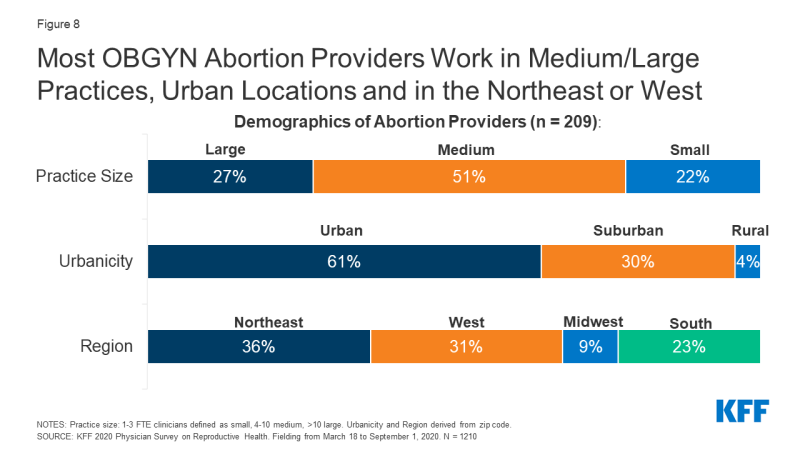
Figure 8: Most OBGYN Abortion Providers Work in Medium/Large Practices, Urban Locations and in the Northeast or West
When looking at practice type, the share of OBGYNs who provided medication and aspiration abortions did not differ between health centers/clinics and private office-based practices (Table 6). However, a smaller share of those in health centers/clinics referred for both medication (51% vs. 66%) and aspiration abortions (51% vs. 66%) compared to those in private office-based practice; for health centers/clinics participating in the Title X Family Planning program, fewer referrals may be due to changes to the program regulations which did not permit Title X recipients to refer patients for abortions at the time the survey was fielded.
Compared to OBGYNs who do not provide abortions, a larger percentage of those who offered abortions provided a choice of all methods of contraception including emergency contraception, and provided same-day IUD and implant placement; this is notable given post-abortion contraception is an important component of abortion care for some women. A higher share of abortion providers also provided a wide range of STI services compared to non-abortion providers, including prescription of PrEP for HIV prevention and prescription of expedited partner therapy (EPT). It was also more common for abortion providers to provide gender affirming care compared to OBGYNs who did not provide abortions at their practice (Figure 9).
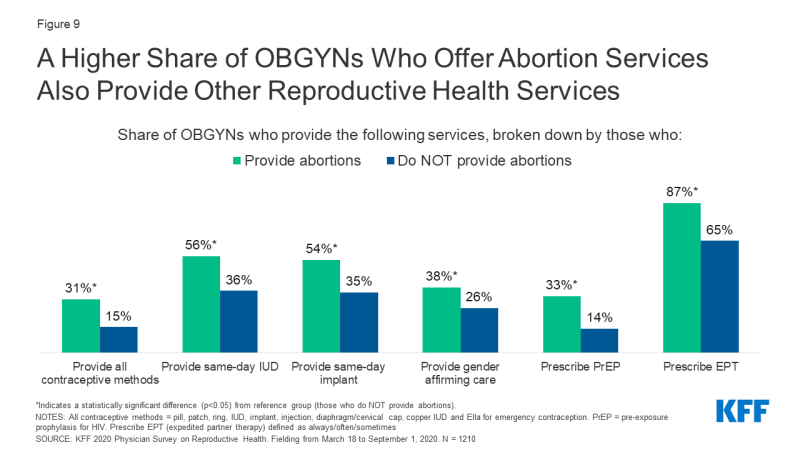
Figure 9: A Higher Share of OBGYNs Who Offer Abortion Services Also Provide Other Reproductive Health Services
characteristics of OBGYNs who DO NOT provide Abortions
Among OBGYNs who do not provide abortions in their practices, most cited more than one reason for not providing abortions. About half (49%) say their practice has a policy against abortions, 45% say services are readily available elsewhere, 31% personally oppose the practice, 17% say there are too many legal regulations and 15% cite safety concerns for staff as their reasons for not providing abortions (Figure 10).
Only 10% reported they did not have adequate training to be providing this service, however this number was higher among the youngest group of physicians, age <45, compared to all older groups (age <45: 20%, 45-54: 7%, 55-64: 3%, 65+: 3%). This may reflect changes to abortion training over time. In 1996, the accrediting organization for OBGYN, the ACGME, instituted a training requirement for OBGYN residency programs to provide training in abortion provision, with opt out options for those with religious or moral objections. In a 2002 study of U.S. OBGYNs, it was found that younger OBGYNs were more likely than older OBGYNs to provide abortion, which was attributed to this change in medical training. However, a study by the National Academies of Sciences, Engineering and Medicine pointed out that not all residency programs follow the ACGME requirement, and that abortion training may have become more limited in recent years due to institutional policies, state laws, and mergers with religiously-affiliated hospitals.
Among those who do not provide abortions, more male OBGYNs personally oppose the practice than female (39 vs. 27%). Additionally, among those who do not provide abortions, 61% of OBGYNs in health centers/clinics say their practice has a policy against performing abortions compared to 47% in private office-based practice; this could reflect federal and state level restrictions on the use of public funds for the provision of or referral for abortion found in the federal Title X program, the Hyde amendment and state laws.
By region, a higher share of OBGYNs in the South reported that the high number of legal regulations associated with abortion (25%) was a reason they didn’t offer abortion compared to OBGYNs in the Northeast (8%) and West (10%). A higher share of OBGYNs in the Midwest (13%) and South (12%) also reported not having enough adequate training to provide abortion compared to OBGYNs in the Northeast (2%) (Figure 11).
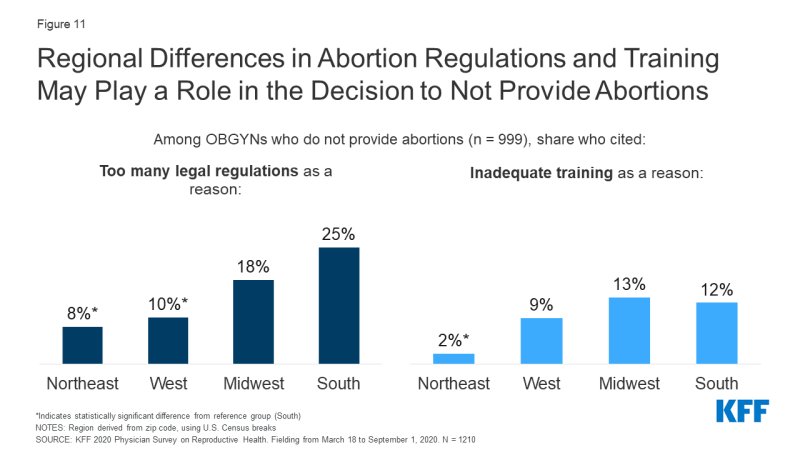
Figure 11: Regional Differences in Abortion Regulations and Training May Play a Role in the Decision to Not Provide Abortions
Most OBGYNs who did not provide abortions, however, referred patients for these services (Figure 5). A small share of OBGYNs (13%) neither provided abortions nor referrals for patients to obtain abortions at another practice or clinic. This was more common among OBGYNs who are male compared to female, and work in practices in the South and Midwest compared to the West and Northeast (Figure 12). No differences were identified by age, practice type, practice size or urbanicity.
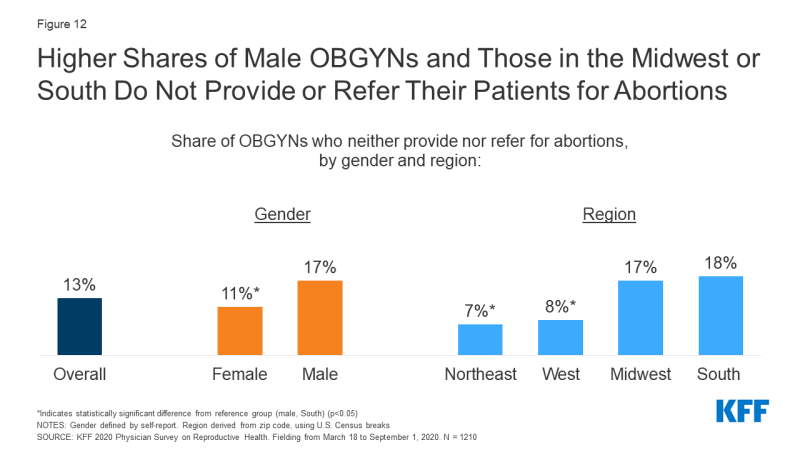
Figure 12: Higher Share of Male OBGYNs and Those in the Midwest or South Do Not Provide or Refer Their Patients for Abortions
Other Sexual and Reproductive Health Services
Care for Sexually Transmitted infections
The United States Preventive Services Task Force (USPSTF) recommends testing for gonorrhea, chlamydia, HIV and syphilis at differing points in people’s lives. The vast majority of OBGYNs provide onsite testing at their practice for gonorrhea and chlamydia (99%), syphilis (90%) and HIV (87%) (Table 7). About a third have onsite have lab processing as well for these STIs (38%/34%/34% respectively), rather than sending samples to outside labs.
| Table 7: Share of OBGYNs Who Provide Onsite STI Testing | ||
| Is onsite testing available at your practice for the following STIs? | ||
| Yes | No | |
| Gonorrhea and Chlamydia | 99% | <1% |
| Syphilis | 90% | 9% |
| HIV | 87% | 12% |
| SOURCE: KFF 2020 Physician Survey on Reproductive Health. Fielding from March 18 to September 1, 2020. N = 1210 | ||
While testing for gonorrhea and chlamydia was near universal, a small share of OBGYNs did not provide onsite testing for syphilis (9%) or HIV (12%) (typically collected via blood draws), meaning a patient would need to visit a separate facility for testing. This is important to note given the rising rates of congenital syphilis, primary and secondary syphilis among women, and HIV among certain groups of women in recent years. A higher share of OBGYNs in private office-based practices compared to health centers/clinics, and in small practices compared to medium and large did not test offer onsite testing for syphilis and HIV (Figure 13).
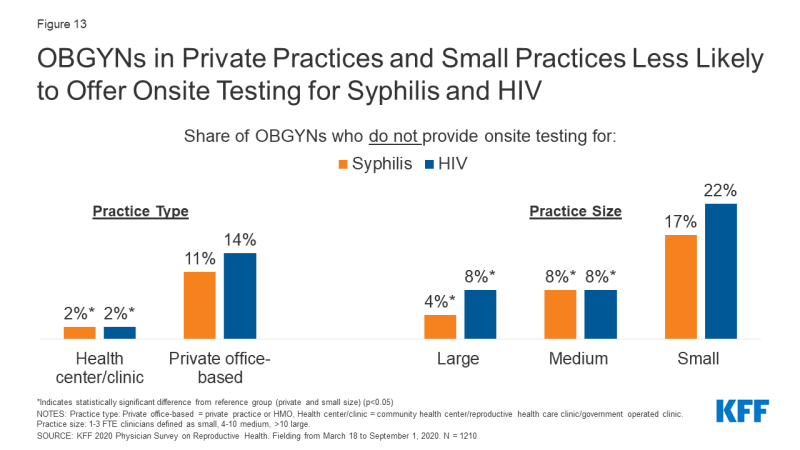
Figure 13: OBGYNs in Private Practices and Small Practices Less Likely to Offer Onsite Testing for Syphilis and HIV
Pre-Exposure Prophylaxis (PrEP) Provision
According to the CDC, there remains a substantial gap, particularly among women, between the number of people with indications to be on the HIV prevention medication known as PrEP, and those who have been prescribed this medication. This may be in part due to a limited number of providers who prescribe PrEP. In our sample of OBGYNs, fewer than one in five (18%) prescribe PrEP for the prevention of HIV. This varied some by physician and practice characteristics; PrEP prescription was more common among younger OBGYNs ages compared to older, and among those in large practices compared to medium and small (Figure 14).
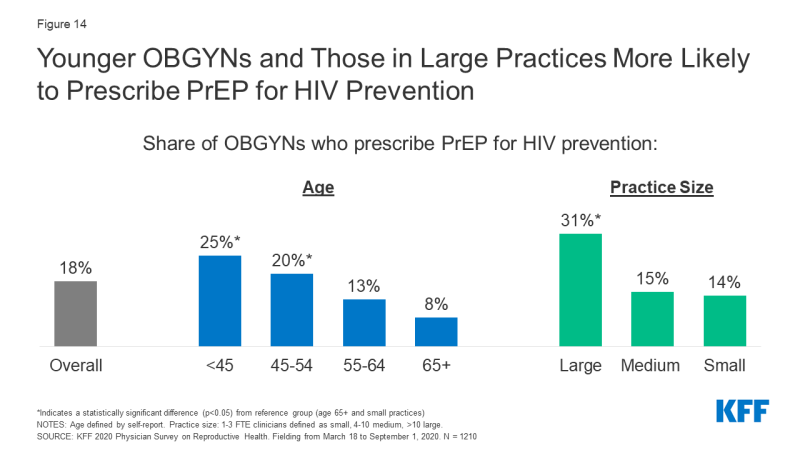
Figure 14: Younger OBGYNs and Those in Large Practices More Likely to Prescribe PrEP for HIV Prevention
Expedited Partner Therapy
OBGYNs varied in how often they prescribed expedited partner therapy (EPT) for sex partners of patients being treated for gonorrhea or chlamydia. EPT describes the practice of prescribing STI treatment for a patient’s sex partner(s) without an in-person medical evaluation of their partner(s). About half of OBGYNs said they always (33%) or often (21%) prescribe EPT for gonorrhea and chlamydia, while some said they do so sometimes (15%). Nearly third said that they rarely (15%) or never (15%) prescribe EPT (Figure 15).
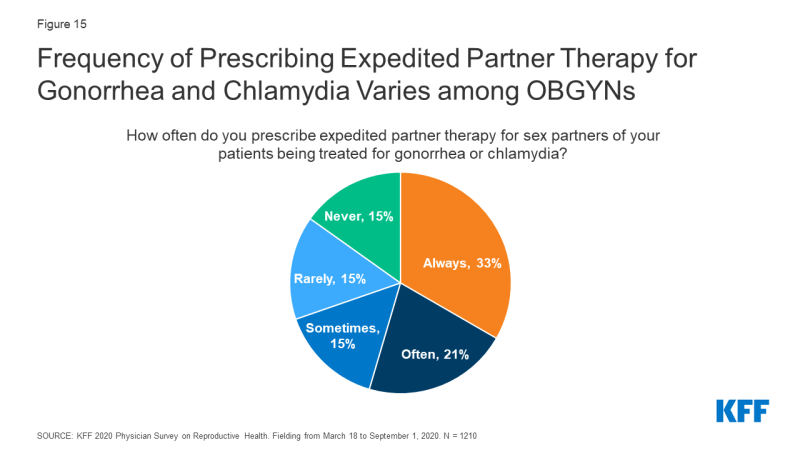
Figure 15: Frequency of Prescribing Expedited Partner Therapy for Gonorrhea and Chlamydia Varies among OBGYNs
Additional SRH Services
Beyond contraception, STIs and abortion care, OBGYNs reported providing a range of other sexual and reproductive health services within their practices, while a small percentage refer their patients to other providers for these services (Table 8). Almost all OBGYNs reported they provide pap smears and human papillomavirus (HPV) testing (98%), colposcopies for abnormal pap smears (96%), basic infertility diagnostic services (90%) and prenatal care for low risk pregnancies (88%) within their practices, however some notable differences in service provision emerged. For example, fewer OBGYNs in health centers/clinics provided basic infertility diagnostics (e.g., lab testing, pelvic ultrasound, semen analysis) as compared to those in private office-based practices (78% vs. 92%). Additionally, provision of prenatal care was less common among older doctors (age 65+) compared to younger doctors, and those in small practices compared to medium or large (Table 9).
| Table 8: Health Care Services Provided by OBGYNs | ||
| Service | Provided within their practice | Referred to another provider |
| Pap Smears and HPV Testing | 98% | 1% |
| Colposcopies | 96% | 3% |
| Basic Infertility Diagnostic Services | 90% | 8% |
| Prenatal Care for Low Risk Pregnancies | 88% | 11% |
| Gender Affirming Care | 28% | 55% |
| NOTES: Responses do not total 100%, as they leave out those who answered that they neither provide nor refer for these services, and those who left the question unspecified SOURCE: KFF 2020 Physician Survey on Reproductive Health. Fielding from March 18 to September 1, 2020. N = 1210 |
||
| Table 9: Provision of Low-Risk Prenatal Care by OBGYNs | ||
| Provides prenatal care for low-risk pregnancies | ||
| Overall | 88% | |
| Age | <45 | 92* |
| 45-54 | 89* | |
| 55-64 | 89* | |
| 65+ | 75 | |
| Practice Size | Large | 95* |
| Medium | 93* | |
| Small | 74 | |
| *Statistically significant difference (p<0.05) from reference group in bold NOTES: Age defined by self-report. Practice size defined by number of full-time equivalent physicians and advance practice clinicians (small ≤3 FTE, medium 4-10, large >10). SOURCE: KFF 2020 Physician Survey on Reproductive Health. Fielding from March 18 to September 1, 2020. N = 1210 |
||
Notably the provision of gender affirming care was less commonly reported than other SRH services. About one in four (28%) OBGYNs reported that gender affirming services were provided at their practice (e.g. hormone therapy or gender affirming surgery) (Table 8). Another 55% refer patients for this care, while approximately one in ten OBGYNS (9%) neither provide nor refer for these services.
A higher share of OBGYNs in younger age groups compared to older worked at a practice offering gender affirming care, as did those who worked at large and medium practices compared to small. Regionally, provision of gender affirming care was more common among OBGYN practices in the West than in the Northeast, Midwest, and South (Figure 16).
Preparedness to Address SRH Needs of LGBTQ Patients
Providers varied in how prepared they felt to meet the sexual and reproductive health care needs of sexual and gender minority patients. Nearly nine in ten (88%) OBGYNs said they were very or somewhat prepared to meet the SRH needs of lesbian, gay, bisexual and queer patients, while the same was true for only 56% of OBGYNs when it came to transgender patients (Figure 17).
Perceived preparedness was higher among certain groups of OBGYNs. OBGYNs more often reported feeling very or somewhat prepared to meet the SRH needs of LGBTQ patients if they were female compared to male, and if they offered gender affirming care at their practices compared to not. Regionally, more OBGYNs in the West felt prepared to meet the SRH needs of transgender patients compared to those in the Midwest or South (Table 10).
| Table 10: Perceived preparedness to meet SRH needs of LGBTQ patients, by physician characteristics | |||
| Characteristics | Share of OBGYNs reported feeling very or somewhat prepared to meet the sexual and reproductive health needs of: | ||
| Gay, lesbian, bisexual and queer patients | Transgender patients | ||
| Overall | 88% | 56% | |
| Gender | Female | 90* | 61* |
| Male | 84 | 48 | |
| Region | Northeast | 87 | 56 |
| West | 89 | 66* | |
| Midwest | 87 | 54 | |
| South | 89 | 51 | |
| Practice provides gender affirming care | Yes | 93* | 81* |
| No | 87 | 47 | |
| *Indicates statistically significant difference from reference group in bold (p<0.05) NOTES: Gender and provision of gender affirming care defined by self-report. Region derived from zip code, using U.S. census breaks. SOURCE: KFF 2020 Physician Survey on Reproductive Health. Fielding from March 18 to September 1, 2020. N = 1210 |
|||
Psychosocial Needs
In recent years, emphasis has been placed on incorporating screening for the social determinants of health and mental health needs into routine clinical care. We asked OBGYNs about their screening and intervention practices for four psychosocial needs—intimate partner violence (IPV), depression, housing and transportation. Nearly all OBGYNs screened patients for IPV and depression. A very small share of OBGYNs reported they do not screen any of their patients for IPV (4%) or depression (2%). This is perhaps not surprising given there are formal recommendations from USPSTF and ACOG to screen for both IPV and depression.
For social needs without formal screening recommendations however, screening was more variable. Almost half of OBGYNs said that they do not screen any of their patients for unmet housing needs (47%) or transportation barriers (45%) (Figure 18).
In the event a patient discloses or screens positive for one of these needs, most OBGYNs referred patients to outside resources for IPV (75%), depression (66%), housing (55%) and transportation (53%). Few had resources or a social worker onsite to address these needs (Figure 19). More than one in four OBGYNs (27%) said they neither have internal resources nor refer to external resources if a patient screens positive for unmet housing or transportation needs.

